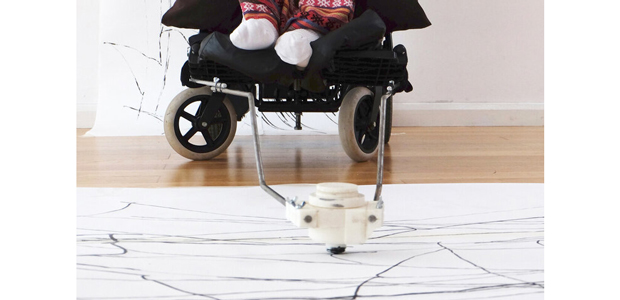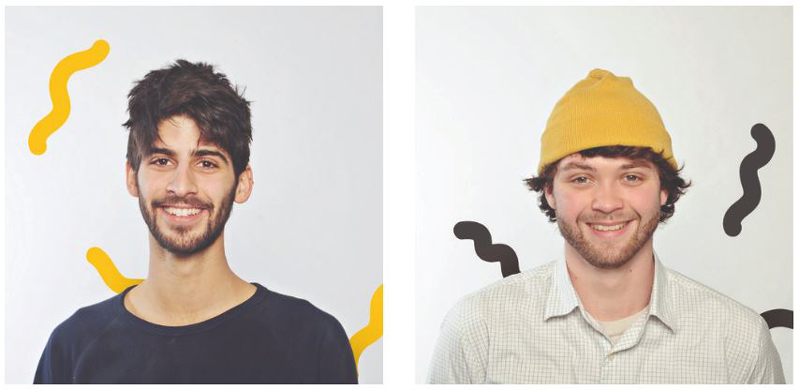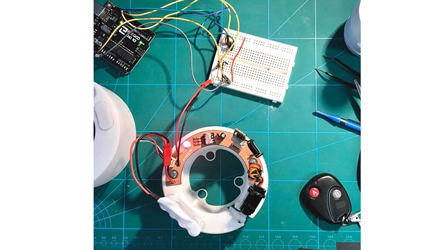
The innovative way to 'Enayball' everyone's creative side
Having recently visited the CRL workspace in Hayes to meet this year’s cohort, sponsored by Mouser, I was overwhelmed with some incredible startup founders and the ideas that had inspired them. One of which was a pair of friends Pete Barr and Eli Heath, who together have created a social enterprise startup to enable people with disabilities to draw, through adding tools to a wheelchair.
“It’s about giving back creativity to physical disability,” Barr explained. “Yes we believe art is a human right, we both love art and creativity and wanted to give this power to everyone,” Heath added.
The duo met whilst studying at university, both being on the product design course at Brighton, and took part in an external project with the Sussex MS centre, around four years ago. “It was a guy called Barry Slug who inspired Enayball, as part of this project we created a tool to add to his wheelchair, and from here it inspired us to take this further and help others,” Barr explained.
It was really solidified for the pair when Barry explained to a worker at the centre that thanks to them it made him finally think again, Heath added: “Barry was particularly pertinent for us, and was the beginning of our journey.”
From here they decided to help more people like Barry and Enayball was born as a product that attaches to a wheelchair, near the floor, and as the user moves the chair a line is painted in synchronicity on the floor below. Since joining CRL the founders have decided they want to expand the product, to help more people with more disabilities and plan to release Enayball as a hand-held device, on a table top.
The name Enayball, has a couple of reasons behind it, once you learn to pronounce it correctly (I did struggle for a moment or two to start with). It derived as the product uses a number of balls underneath it to help it move around when drawing. Heath added: “The balls enable the product but the product enables people.”

Talking about the technology the product uses, both explained it includes electronics and PCBs to remotely lift the pen, which is aided through servo motors. The remote control is connected wirelessly through Bluetooth.
“There is a button designed to attach to the body, table or wheelchair. We made this button agile so it can be adapted and move about, so we can reach more people,” Barr explained.
Heath continued: “It was an interesting challenge, as people are diverse and so are disabilities – so anything is better when it can be adapted. We wanted to design our product with the ability to change and adapt to suit everyone.”
The Enayball founders chose to use 3D printing to allow them to print a large quantity but with flexibility, rather than inject moulding. “3D Printing enables this high tech solution, as it allows personalisation which is the element that makes it adaptable,” Barr said.

Through the design process Enayball has partnered with charities, Barr explained: “The user feedback has allowed us to adapt and design further, as we have more of an understand as to what people want.”
CRL really helped with the design process too. “To start with we just focused on paralysed people, which was a smaller market and harder to make money, so we needed to expand. It was beneficial in a business sense, and we were also improving more people’s lives – so it was a win-win,” Heath added.
The pair are aiming for a Kickstarter launch with Enayball at the end of the year. “We are sprinting to get the product to that stage, then we will react from there,” Barr explained.
Heath added: “We could end up batch producing as orders come in, and if we get a good reception we will be looking at a bigger production plan.”
Having taken the plunge with the Enayball idea just over two years ago, the pair said the journey has been a real learning curve, Heath added: “A very steep one. In retrospect our ambitions were huge, we were a bit naive to begin with, but coming to CRL was a big reality check.”

As COVID struck it did affect Enayball massively, as they had planned to be at an event where Alison Lapp MBE had been asked to be an ambassador. “It was a big event, there was going to be a lot of press there and it was going to be a big day for us, and then COVID happened,” Barr explained.
“We had planned to get a lot of new material, pictures and videos, as the website hasn’t been updated since 2106, but that will have to wait,” Heath laughed.
As the pair’s work revolves around working with vulnerable people and charities, the work came to a complete stop during the pandemic so user testing stopped too. This gave the guys a lot of time and so they decided to work on an additional concept and have developed a sustainable hand sanitising refillable, portable, built for life product which will sanitise your hands in less than two seconds.
Soapstone is the sustainable way to keep germfree. At the press of a button, it dispenses sanitiser onto your hands. The 'Single Use Plastics Revolution' has been side-tracked and hand sanitiser bottles are being found in our oceans. Heath explained they want people to “become part of the solution, not the problem.”
Heath said: “Everyone’s life is changing, and even after the pandemic people will continue to hand sanitise. Currently the options are small, single use plastic – we saw this as an opportunity to rectify this. So we created a metal - made from recycled aluminium - and refillable solution that comes in bigger quantities. This is a lifestyle product and will encourage more people to have the sanitiser.”
Soapstone is now available on Kickstarter, so the plan is to launch this to deliver the sustainable alternative to hand sanitising solutions, and then long term hope to launch Enayball on Kickstarter and bring accessibility to as many people as possible.


